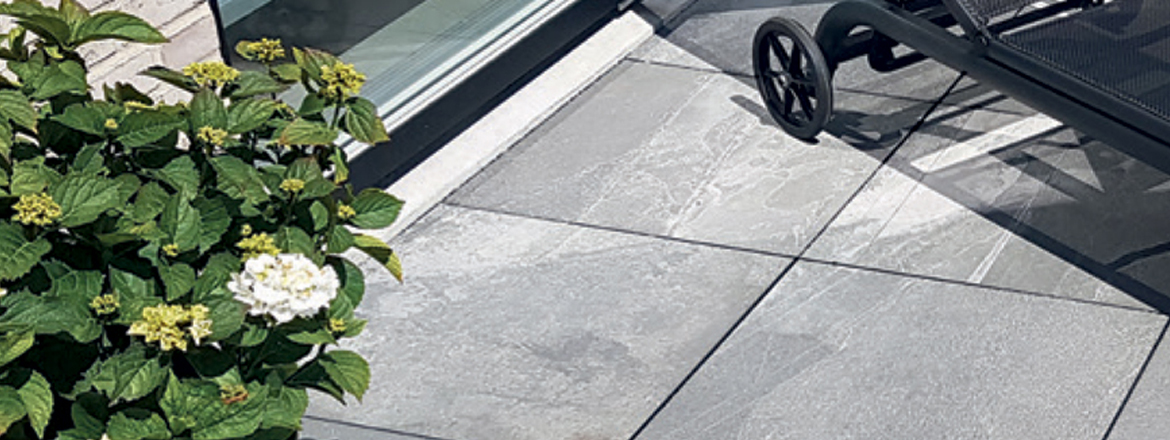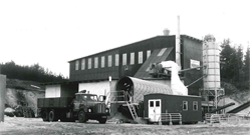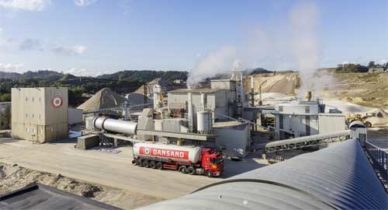DANSAND Kerama® tips
Find tips and FAQ answers here.

Effect
The washed and dried silica sand in Dansand Kerama® is enhanced with a mineral additive and a flexible binding agent. The naturally high pH value in the mineral additive creates a low-nutrient environment in the joint. Weed seeds will dry out before they can germinate. The binding agent makes the filling material resistant to rain and surface water, ensuring that weeds are kept under control for a long time.
DANSAND Kerama® cannot prevent moss and algae from forming. These typically grow in joints that are constantly moist or in shaded areas. You can apply a suitable prevention agent against moss and algae to keep the problem under control. You can also remove the moss-filled joints using a suitable tool and sweep new DANSAND Kerama® joint filling sand into the joints.
The problem with moss and algae can be somewhat mitigated by always ensuring that the joints are filled.
Application
The ideal width of the joint is 3 to 10 mm. This should not be exceeded, or the joint will not be robust and durable. If the joint is too narrow, the filling material will not harden sufficiently. If the joint is too wide, it becomes weak and can crack or shear off when exposed to loads.
We normally recommend a joint depth of 40 mm. However, DANSAND Kerama® is effective at depths of just 20 mm. This is due to the fact that we have added a flexible binding agent making the material extremely resistant to rain and standing water. The result: Stable, flexible and elastic joints.
We have added minerals and binding agents to the silica sand. This may gather at one side of the bag. Before use, you should mix the content of the bag using a shovel to ensure a good mix of the content. Never mix the contents from more than two bags at a time.
The joint material and the paving stones must be completely dry before you begin sweeping the filling material into the joints. Otherwise the binding agents will activate, sticking to the paving surface and creating a grayish film. For the same reason you should also be extra careful to sweep the paving surface clean using a soft broom, before you begin compacting the filling material.
No, do not use a vibrating plate on ceramic tiles – they are typically large and thin and may crack. DANSAND Kerama® is compacted by moistening the joints carefully twice.
Moisten the joints using a fine spray setting on your garden hose nozzle. Wait 24 – 48 hours and top up the joints with filling material. Sweep the paving completely clean with a soft brush and repeat.
The surface must be entirely dry when you top up the joints.
The weed-retardant effect only works if the product is unmixed. You should never mix it with other materials such as cement or other types of sand.
Application area
No, you cannot use DANSAND Kerama® with burnt tiles or paving clinkers. You risk efflorescence on the paving stones. Hard-burnt tiles will absorb moisture from the silica sand in the filling material. DANSAND Kerama® also contains a weed-retardant mineral containing salts that will seep into the tiles or clinkers and cause efflorescence. As the mineral is intended to have a long-term weed retardant effect, any efflorescence will remain for a long period of time.
Plaster used for plinths is typically more porous than paving stones and may absorb salts from the filling material, leading to efflorescence. This cannot be removed. Instead, you should use neutral filling sand or construction sand. Weeds rarely grow next to the plinth, as the joint next to the plinth stays mostly dry, leaving poor growth conditions for weeds.
You can use DANSAND Kerama® in covered areas such as a car shelter or a covered patio. However, since these areas are free from rain, excess salts and minerals from the filling material may migrate to the surface of the joints, causing white efflorescence. This typically happens in spring or summer, aided by warmer air. Efflorescence can also emerge on the edges of the paving stones.
Unlike efflorescence on the house plinth, such efflorescence can be swept or washed off. During warmer periods, it may reappear. If you persist in cleaning it away, it will eventually fade as the mineral content of the filling material declines.
You should only use DANSAND Kerama® on an unbound surface, ie. a substrate of sand and gravel on top of raw soil.
Kerama is water permeable and requires drainage. A bound substrate, such as concrete or wood, will retain moisture. The binding agents will not harden properly. As a result a stable and semi-hard joint will not be created.
In addition, in the spring and summer months, white feasts will appear in the joints and on the edges of the tiles.
No. DANSAND Kerama® is not suitable for areas adjoining swimming pools. The joint filling material only works as intended if it can dry out completely, so we cannot guarantee its effect in a permanently wet environment.
Problems
Joint filling materials with binding agents can leave a grayish residue or haze on the paving. This often occurs as a result of excess watering or if the paving was not swept completely clean before watering. The paving stones are not ruined, however. The efflorescence will normally disappear as the paving is exposed to water, wind or snow. You can also remove it yourself.
White haze or efflorescence on the edges of paving stones:
The white haze is caused by mineral salts. It is a naturally occurring phenomenon that often occurs during warm periods such as spring or early summer. The combination of moist air and heat will draw salts on to the paving. The moisture may stem from wet substrate due to heavy rain. Rain will eventually wash the efflorescence away, but normal traffic and/or cleaning may also remove it.
Efflorescence on the paving stones: This may be caused by the paving stone material itself or by having a bound substrate. See
What happens if I use DANSAND® Kerama on a bound surface?
There are essentially two types of weeds: Weeds that spread through a root network, and airborne weed seeds that settle in the joints.
Weeds that spread through a root network:
Before filling your joints with DANSAND Kerama®, be sure to remove all existing weeds and their root network. DANSAND Kerama® is not a weed-killer; it creates a poor growth environment for weeds so that seeds cannot set root. Due to the high pH value (approx. 10.4), roots will simply dry out.
Airborne weed seeds: To avoid airborne seeds from setting roots, ensure that the joint is filled in its entire height – 20 mm minimum. Joints should always be filled to the top, so remember to top up the joints from time to time and to keep the paving surface free from dirt and leaves.
Maintenance and cleaning
Absolutely – this is how you keep your joints clean and long-lasting. You also protect your paving in this way, avoiding subsidence, edge peeling, frost damage and so forth.
Always ensure that the joints are filled to the top with filling material. Keep them free from grass, dirt, leaves and other organic matter. Sweep your paving regularly and top up the joints when needed.
Tip!
Inspect your joints in early spring and assess what needs to be done. Is it sufficient to top up the joints or do you need a more thorough renovation?
We recommend three different approaches – read about it here.
DANSAND Kerama® is self-reparing. As the joint filling material gets wet, the binding agent is reactivated and cracks in the surface will be sealed. Larger cracks can be repaired by topping up the joints with fresh DANSAND Kerama®.
Fill DANSAND Kerama® into the joint and sweep the surface using a soft broom. Now carefully moisten the joint using mist setting on your garden hose nozzle.
Repair the joints during dry weather and a temperature of 5 degrees Celsius as a minimum. Ensure that the paving surface is entirely dry.
Safety and environment
Yes. All our NO GROW™ filling materials are free from harmful substances. DANSAND Kerama® is made entirely from silica sand, natural high pH minerals and a natural binding agent.
Using a DANSAND® NO GROW™ filling material in your joints means waving goodbye not just to hard work – you can also wave goodbye to harmful chemicals.






